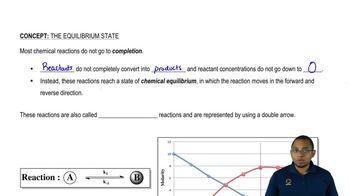Here are the essential concepts you must grasp in order to answer the question correctly.
Equilibrium Constant (K)
The equilibrium constant (K) is a numerical value that expresses the ratio of the concentrations of products to reactants at equilibrium for a given chemical reaction. It is calculated using the formula K = [C]^c / ([A]^a * [B]^b), where [C], [A], and [B] are the molar concentrations of the products and reactants, and a, b, and c are their respective coefficients in the balanced equation.
Recommended video:
The Equilibrium Constant Concept 1
Chemical Equilibrium
Chemical equilibrium occurs when the rates of the forward and reverse reactions are equal, resulting in constant concentrations of reactants and products over time. At this state, the system is dynamic, meaning that reactions continue to occur, but there is no net change in the concentration of substances involved.
Recommended video:
Chemical Equilibrium Concept 1
Stoichiometry
Stoichiometry is the calculation of reactants and products in chemical reactions based on the balanced equation. It involves using the coefficients of the balanced equation to determine the proportions of substances involved, which is essential for calculating the equilibrium constant and understanding the relationships between different species in a reaction.
Recommended video:

 Verified step by step guidance
Verified step by step guidance


